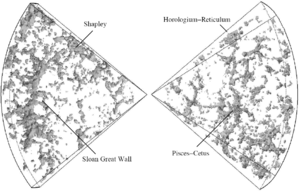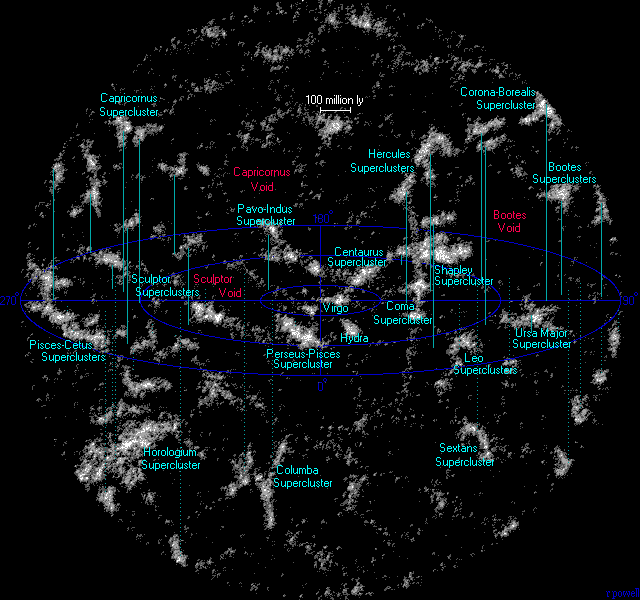User:PHenry/Rescue Squad/Large-scale structure of the cosmos
| Part of a series on |
| Physical cosmology |
|---|
 |
In physical cosmology, the large-scale structure of the universe refers to the characterization of observable distributions of matter and light on the largest scales (typically on the order of billions of light-years). Sky surveys and mappings of the various wavelength bands of electromagnetic radiation (in particular 21-cm emission) have yielded much information on the content and character of the universe's structure. The organization of structure appears to follow as a hierarchical model with organization up to the scale of superclusters and filaments. Larger than this, there seems to be no continued structure, a phenomenon which has been referred to as the End of Greatness.
Walls, filaments and voids
[edit]
The organization of structure arguably begins at the stellar level, though most cosmologists rarely address astrophysics on that scale. Stars are organized into galaxies, which in turn form clusters and superclusters that are separated by immense voids, creating a vast foam-like structure sometimes called the "cosmic web". Prior to 1989, it was commonly assumed that virialized galaxy clusters were the largest structures in existence, and that they were distributed more or less uniformly throughout the universe in every direction. However, based on redshift survey data, in 1989 Margaret Geller and John Huchra discovered the "Great Wall," a sheet of galaxies more than 500 million light-years long and 200 million wide, but only 15 million light-years thick. The existence of this structure escaped notice for so long because it requires locating the position of galaxies in three dimensions, which involves combining location information about the galaxies with distance information from redshifts. In April 2003, another large-scale structure was discovered, the Sloan Great Wall. In August 2007, a possible supervoid was detected in the constellation Eridanus.[1] It coincides with the 'WMAP Cold Spot', a cold region in the microwave sky that is highly improbable under the currently favored cosmological model. This supervoid could cause the cold spot, but to do so it would have to be improbably big, possibly a billion light-years across.
In more recent studies the universe appears as a collection of giant bubble-like voids separated by sheets and filaments of galaxies, with the superclusters appearing as occasional relatively dense nodes. This network is clearly visible in the 2dF Galaxy Redshift Survey. In the figure a 3-D reconstruction of the inner parts of the survey is shown, revealing an impressive view on the cosmic structures in the nearby universe. Several superclusters stand out, such as the Sloan Great Wall, the largest structure in the universe known to date.
End of Greatness
[edit]The End of Greatness is an observational scale discovered at roughly 100 Mpc (roughly 300 million lightyears) where the lumpiness seen in the large-scale structure of the universe is homogenized and isotropized as per the Cosmological Principle. The superclusters and filaments seen in smaller surveys are randomized to the extent that the smooth distribution of the universe is visually apparent. It was not until the redshift surveys of the 1990s were completed that this scale could accurately be observed.[2]
Observations
[edit]
Another indicator of large-scale structure is the 'Lyman alpha forest'. This is a collection of absorption lines which appear in the spectral lines of light from quasars, which are interpreted as indicating the existence of huge thin sheets of intergalactic (mostly hydrogen) gas. These sheets appear to be associated with the formation of new galaxies.
Some caution is required in describing structures on a cosmic scale because things are not always as they appear to be. Bending of light by gravitation (gravitational lensing) can result in images which appear to originate in a different direction from their real source. This is caused by foreground objects (such as galaxies) curving the space around themselves (as predicted by general relativity), deflecting light rays that pass nearby. Rather usefully, strong gravitational lensing can sometimes magnify distant galaxies, making them easier to detect. Weak lensing (gravitational shear) by the intervening universe in general also subtly changes the observed large-scale structure. In 2004, measurements of this subtle shear show considerable promise as a test of cosmological models.
The large-scale structure of the Universe also looks different if one only uses redshift to measure distances to galaxies. For example, galaxies behind a galaxy cluster will be attracted to it, and so fall towards it, and so be slightly blueshifted (compared to how they would be if there were no cluster); on the near side, things are slightly redshifted. Thus, the environment of the cluster looks a bit squashed if using redshifts to measure distance. An opposite effect works on the galaxies already within the cluster: the galaxies have some random motion around the cluster centre, and when these random motions are converted to redshifts, the cluster will appear elongated. This creates what is known as a finger of God: the illusion of a long chain of galaxies pointed at the Earth.
Cosmography of our neighborhood
[edit]At the centre of the Hydra supercluster there is a gravitational anomaly, known as the Great Attractor, which affects the motion of galaxies over a region hundreds of millions of light-years across. These galaxies are all redshifted, in accordance with Hubble's law, indicating that they are receding from us and from each other, but the variations in their redshift are sufficient to reveal the existence of a concentration of mass equivalent to tens of thousands of galaxies.
The Great Attractor, discovered in 1986, lies at a distance of between 150 million and 250 million light-years (250 million is the most recent estimate), in the direction of the Hydra and Centaurus constellations. In its vicinity there is a preponderance of large old galaxies, many of which are colliding with their neighbours, and/or radiating large amounts of radio waves.
In 1987 Astronomer R. Brent Tully of the University of Hawaii’s Institute of Astronomy identified what he called the Pisces-Cetus Supercluster Complex, a structure which he said was one billion light years long and 150 million light years across.[4][5]
Modeling
[edit]There is much work in cosmology which attempts to model the large-scale structure of the universe.e.g.[6] Using the big bang model and assumptions about the type of matter that makes up the universe, it is possible to predict the expected distribution of matter, and by comparison with observation work backward to support and refute certain cosmological theories. Currently, observations suggest that most of the mass in the universe must be composed of cold dark matter. Models which assume hot dark matter or baryonic dark matter do not provide a good fit with observations. The irregularities in the cosmic microwave background radiation and high redshift supernovae give complementary approaches to constraining the same models, and there is a growing consensus that these approaches together are giving evidence that we live in an accelerating universe.
Map
[edit]
References
[edit]- List of publications of the 2dF Galaxy Redshift Survey
- List of publications of the 6dF Galaxy Redshift and peculiar velocity survey
Notes
[edit]- ^ Biggest void in space is 1 billion light years across - space - 24 August 2007 - New Scientist Space
- ^ Robert P Kirshner (2002). The Extravagant Universe: Exploding Stars, Dark Energy and the Accelerating Cosmos. Princeton University Press. p. 71. ISBN 0691058628.
- ^ "Large Scale Structure in the Local Universe: The 2MASS Galaxy Catalog", Jarrett, T.H. 2004, PASA, 21, 396
- ^ Massive Clusters of Galaxies Defy Concepts of the Universe N.Y. Times Tue. November 10, 1987:
- ^ Map of the Pisces-Cetus Supercluster Complex:
- ^ Springel, V.; et al. (June 2005). "Simulations of the formation, evolution and clustering of galaxies and quasars". Nature. 435 (7042): 629–636. arXiv:astro-ph/0504097. Bibcode:2005Natur.435..629S. doi:10.1038/nature03597. PMID 15931216.
{{cite journal}}: Explicit use of et al. in:|author=(help)
Further reading
[edit]- Vicent J. Martínez, Jean-Luc Starck, Enn Saar, David L. Donoho, Simon Reynolds, Pablo de la Cruz, and Silvestre Paredes (November 2005). "Morphology Of The Galaxy Distribution From Wavelet Denoising". The Astrophysical Journal. 634: 744–755. arXiv:astro-ph/0508326. Bibcode:2005ApJ...634..744M. doi:10.1086/497125.
{{cite journal}}: CS1 maint: multiple names: authors list (link) - J. R. Mureika and C. C. Dyer (2005-05-17). "Multifractal Analysis of Packed Swiss Cheese Cosmologies". Classical and Quantum Gravity. arXiv:gr-qc/0505083.
- Mureika, J. R. and Dyer, C. C. (January 2004). "Review: Multifractal Analysis of Packed Swiss Cheese Cosmologies". General Relativity and Gravitation. 36: 151–184. arXiv:gr-qc/0505083. Bibcode:2004GReGr..36..151M. doi:10.1023/B:GERG.0000006699.45969.49.
{{cite journal}}: CS1 maint: multiple names: authors list (link) - Gott, III, J. R.; et al. (May 2005). "A Map of the Universe". The Astrophysical Journal. 624: 463–484. arXiv:astro-ph/0310571. Bibcode:2005ApJ...624..463G. doi:10.1086/428890.
{{cite journal}}: Explicit use of et al. in:|author=(help)CS1 maint: multiple names: authors list (link) - F. Sylos Labini, M. Montuori and L. Pietronero (1998). "Scale-invariance of galaxy clustering". Physics Reports. 293: 61–226. arXiv:astro-ph/9711073. Bibcode:1998PhR...293...61S. doi:10.1023/B:GERG.0000006699.45969.49.
External links
[edit]- "Millennium Simulation" of structure forming Max Planck Institute of Astrophysics, Garching, Germany
- The Sloan Great Wall: Largest Known Structure? on APOD
- Hubble, VLT and Spitzer Capture Galaxy Formation in the Early Universe.
